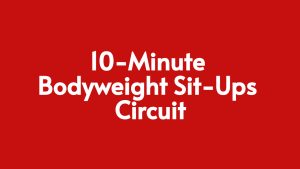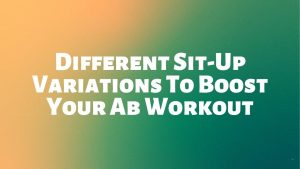When it comes to the health benefits of doing situps for overweight starters, the results are mixed. Core exercises aren’t as crucial as some people think. If you want to lose weight, you must eat less calories than you burn off each day while also engaging in some form of cardiac exercise.
However, you should prioritize weightlifting over core exercises because they are the last thing you should spend time on. So, you can skip them for now and perform them later. Do include some core work in your workout if you have the time, but don’t stress about it.
There is no data to support the claim that situps are ineffective for fat individuals. Different slow but effective approaches can produce good results.
Build up to a situp by strengthening and flattening your abs first. Work on strengthening the three abdominal muscular groups involved in a situp so you can perform a situp more easily. To begin, use a resistance band or even a robe belt. Modify your situp routine at home or in a fitness center.
Tummy Compressions and Roll-Up Teaser
Step 1: Transverse abdominis is the deepest abdominal muscle you can learn to control. Bend your knees and lay on your back. Take a deep breath in through your nose while raising your arms aloft. Take a deep breath out and bring your ribs and abdomen all the way to your spine.
Step 2: As you get used to the sensation of engaging and squeezing your abdomen, execute these stomach compressions 15 times a day.
Step 3: Increase the number of reps by one to work your rectus abdominis, which is also known as the “six-pack muscle.” Assume a supine position with your arms straight out in front of you. Use your nose to take a deep breath in. Exhale with pursed lips and pretend to blow out your bellybutton like a birthday candle. Keep an eye on how your stomach flattens out. This is a teaser that you roll up.
Step 4: Do 15 repetitions of the roll-up teaser each day. Keep calm and wait for the right moment. After six to eight weeks of regular and correct exercise, substantial improvements will have occurred. Sit-ups work your abdominal muscles while also flattening and reshaping your midsection.
Resistance Band Roll-Down
Step 1: Resistance-band roll-downs will help you get closer to executing situps with your newly contoured and stronger abdomen. Make a “V” with your legs and sit as high as you can.
Step 2: Put a robe belt or resistance band around your ankles and place your feet in it as you’re in a stirrup. Grab the belt’s ends and pull them all the way in until they are snug. If you’re using a resistance band, keep it at a comfortable tension. Ensure that your pelvis is tucked in and that your spine is gently curled into a crescent shape.
Step 3: Use your nose to take a deep breath in. After you’ve exhaled, squeeze your abdominals and ribs together toward your spine, then roll your spine down to the mat slowly and steadily. The negative muscle contraction used in situps helps to flatten and strengthen your abs at the same time.
Modified Sit-up
Step 1: Hold on to the robe belt and stay on your back. Bring your heels to the floor by bending your knees and flexing your feet. Keep your feet wide apart and your belt snug around your arches when you exercise.
Step 2: Take a deep breath in through your nose, then exhale slowly. Take a deep breath out and roll your spine off the floor while compressing your abdomen downward.
Step 3: Sit up straight and work your abdominal muscles while still wearing the belt. Rise with your knees wide open, allowing enough room for your tummy to expand.
Step 4: As you rise, use your leg muscles to tighten the robe belt around your waist. Finish your situp by bringing your knees to your chest.
Things You’ll Need
- Robe belt
- Resistance band
To prevent the stretch bands from slipping over your toes, point your toes slightly forward. Like a rubber band, a resistance band can snap. It’s important to begin every move with a small amount of tension so that it can stretch without snapping.
Holding your breath raises your blood pressure, so breathe in between each situp motion.
A hernia should be ruled out if you feel various types of abdominal pain in addition to muscle exhaustion.




